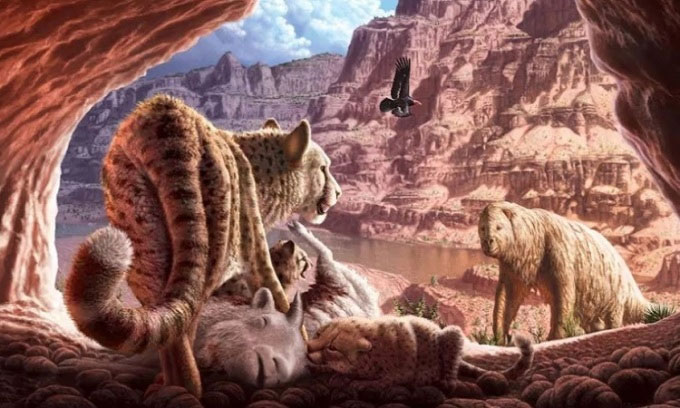Fatal Wounds from a Battle with Its Own Kind Lead to the Extinction of the Ancient American Cheetah.
20,000 years ago, in a cave on the rocky cliffs of the Grand Canyon, two cheetahs engaged in a fierce battle. The juvenile cheetah was bitten through the spine, likely dying as it fell to the cave floor, leaving behind a skeleton and some tissue that had turned into a mummy.

Reconstruction of two ancient American cheetahs possibly fighting to claim territory. (Photo: Julius Csotonyi).
The bones of the unfortunate cheetah, along with fossils from two other caves in the Grand Canyon, reveal that the extinct American cheetah (Miracinonyx trumani) may not have been a terrestrial species like the modern African cheetah (Acinonyx jubatus). Instead, they resembled today’s snow leopards (Panthera uncia) more, roaming the cliffs and primarily preying on mountain goats or bighorn sheep.
The research team discovered the fossils decades ago. At that time, they identified the skeleton as belonging to the cougar (Puma concolor). However, recent analysis has revealed that the fossils actually come from the American cheetah. This species is a close relative of the cougar but has a shorter snout and a more elongated body similar to the modern African cheetah.
The American cheetah went extinct around 10,000 years ago. Before the last Ice Age ended, they lived throughout North America. Researchers have discovered their fossilized bones from West Virginia to Arizona and Wyoming. The speed of this extinct big cat helps explain why pronghorns (Antilocapra americana) can run up to 60 mph. Among modern predators that specialize in hunting pronghorns, none can run that fast. However, the American cheetah could achieve such speeds.
While some cheetah fossils are located in the wide valley where ancient pronghorns lived, many other fossils were excavated from steep rocky mountains, which had numerous caves providing warm shelter, according to John-Paul Hodnett, a paleontologist with the Maryland-National Capital Park and Planning Commission and the lead researcher.
In 2019, Hodnett and his colleagues worked with fossil records in the Grand Canyon National Park. He found leg bones in the Next Door Cave and Stanton Cave, both located in the eastern Grand Canyon, that belonged to the American cheetah. But the most remarkable discovery was the skeletons of two American cheetahs in Rampart Cave. The juvenile cheetah had been attacked with multiple puncture wounds in its skull and spine. These were all fatal injuries.
The researchers are unsure whether the two cheetahs were related, but the soft tissue still attached to the bones may provide enough DNA for further analysis. The injuries on the young cheetah could be the result of a territorial battle or a male cheetah trying to kill the offspring of a rival. The research team published their findings in the May issue of the New Mexico Museum of Natural History Bulletin.


















































